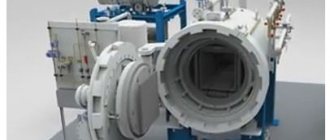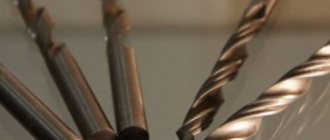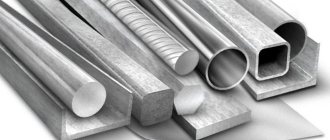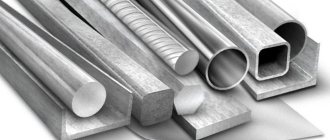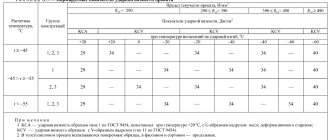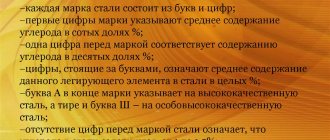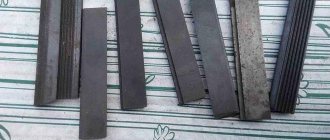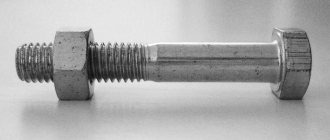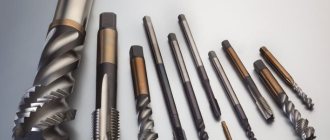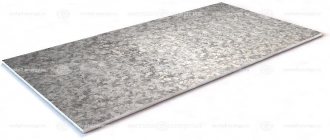Areas of application of tool steels
Tool steel is an alloy with a carbon content of at least 0.7%. Its structure can be hypoeutectoid, ledeburite or hypereutectoid. Tool steels with different structures are distinguished by the presence of secondary carbides. There are no secondary carbides in alloys with a hypoeutectoid structure. Meanwhile, in each of these structures, carbides are necessarily present: they are formed during eutectoid modifications or are the result of the decomposition of martensite.
Scheme-classification of instrumental materials
In modern industry, tool steels are widely used. They are used to produce:
- working parts of dies operating on the principle of cold and hot deformation;
- high-precision products;
- cutting tool;
- measuring instruments;
- casting molds that operate under pressure.
Depending on the area of application of tool steels, certain requirements are imposed on them. However, there are compliance criteria common to all brands:
- a sufficient level of viscosity (this characteristic is especially relevant for parts subject to shock during operation);
- high strength;
- wear resistance;
- high level of hardness.
Brands of alloys intended for use in cold deformation conditions must, in addition, have a smooth working part, the ability to retain size and shape, and also have different yield and elasticity strengths. And tool steel, suitable for work under conditions of hot deformation, must have high thermal conductivity, resist tempering and be resistant to temperature fluctuations. The grades of steel used for the production of cutting tools must also meet special requirements.
Heat treatment of metal
Magazine “Modeler-Constructor”, No. 5, 1994, p. 24 A. Vinogradov
HEAT TREATMENT OF METAL
Modelers constantly have to face the need to increase the strength and hardness of a metal or tool, and sometimes, on the contrary, to make the metal softer and easier to process. This can be achieved by thermal action, which consists of heating the material to a certain temperature, followed by rapid or slow cooling. It is, of course, most convenient to heat parts in electric muffle furnaces; but you can also use blowtorches, gasoline and gas burners, and even the burners of home gas stoves to heat small parts. The most important condition for proper heat treatment of steels is the selection of the required temperature conditions depending on the grade of steel. But due to the fact that there is a limited number of steel grades available for free sale, it is necessary to mainly use either secondary raw materials or make some tools from others. Markings of carbon steel of ordinary quality are indicated by two letters and a number (Art. 1 - Art. 7). The figure in this case shows the approximate carbon content in hundredths of a percent. In grades of high-quality carbon steels - structural (steel 30; steel 45) and automatic steels (A12; A30) the figures also show the approximate carbon content in hundredths of a percent. The most widely used steels are tool steels (U7; U8; U8A; U10A...) - the number in their marking means the carbon content in tenths of a percent; the letter A at the end of the brand indicates that these steels have a reduced content of harmful impurities. Alloy steels are marked with letters and numbers. The letters indicate the presence of one or a whole group of alloying components in the steel: B - tungsten; G - manganese; K - cobalt; M - molybdenum; N - nickel; C—silicon; F - vanadium; X - chromium; Yu - aluminum. For example, steel grade 65X13 contains 0.065% carbon and 0.013% chromium. The most popular steel grades for tool manufacturing are given in Table 1.
Table 1.
| Tool | steel grade |
| Chisels, screwdrivers, axes, steel stamps Punches, dies, punches, chisels Cores, woodworking tools Hammers, sledgehammers, smoothers, carpentry tools Taps Needle files Files Machine hacksaw blades Hand hacksaw blades Wood hacksaws Planer knives Circular saws Sawmill frame saws Dies Blades bow saws Cross saws Longitudinal saws Cutters for hard metals Turning and planing cutters Spiral drills for wood Drills for metal Milling cutters | U7A U8; U8A U10; U10A U7 U11; P9; 9ХС У10 - У12 У10 - У13; ШХ6 Р9; P18; ShH15 U8 - U12 U8GA 9Х5ВФ 85ХФ 85ХВ 9ХС У8Га; 85HF U8GA; U10 85X U13; U13A U10; U10A 9ХС; 9Х5ВФ Р9; P18 P9; P18 |
Heat treatment of steel is divided into hardening, tempering and annealing. Hardening steel is used to increase its hardness. Soft low-carbon steels (Art. 25) and “iron” (Art. 10; Art. 20) do not heat up; carbon (steel 45; steel 50) and tool (U8; U9; U10; U10A and others) increase their hardness during hardening by three to four times. The hardening process consists of heating the steel to the hardening temperature (each brand has its own) and rapidly cooling it in oil or water. Temperature conditions for hardening are given in Table 2.
Table 2.
| Brand | Hardening C° | Holiday C° | Annealing C° | Cooling medium for quenching | Cooling medium for holiday |
| U7; U7A U8; U8A U10; U10A U11; U11A U12; U12A U13; U13A U8GA R9 R18 ShKh6 ShKh9 ShKh15 9KhS 9Kh5VF 50KhGA 60S2 60S2KhA 65S2VA 85KhV | 800 800 790 780 780 780 800 1250 1300 810 830 845 860 950 840 870 870 850 830 | 170 170 180 180 180 180 180 580 580 200 280 400 170 270 315 325 315 330 250 | 780 770 770 750 750 750 770 860 860 780 780 780 730 800 810 840 840 820 790 | water water water water water water water oil oil oil oil oil oil oil water water water water water | water, oil water, oil water, oil water, oil water, oil water, oil water, oil air in the oven air in the oven air air air air air air air air air air |
At home, in the absence of appliances, the heating temperature can be approximately determined by color. For orientation, the colors of the heat of steel products in a non-sunlit room are given in the order of their appearance depending on the temperature (in °C): dark brown (visible in the dark) 530-580 brown-red 580-650 dark red (cherry) 650- 730 cherry-red (crimson) 730-770 cherry-scarlet 770-800 light cherry-scarlet 800-830 bright red 830-870 red 870-900 orange 900-1050 dark yellow 1050-1150 light yellow 1150-1250 yellow-white 1250-1300 dazzling white St. 1300. In the hardened state, steel has great hardness, but at the same time brittleness. To give it toughness, the steel is tempered after hardening. To do this, it is heated to a temperature of 220-300°C and slowly cooled in air. At the same time, the hardness of the steel decreases somewhat, its structure changes, and it becomes more viscous. By changing the tempering temperature, different mechanical properties can be obtained. When steel is heated in air, its surface is painted in different colors, called tarnish colors. Each color of tarnish corresponds to a very specific temperature and can serve as an indicator for determining the degree of heating when tempering steel. Thermal regimes and the corresponding tarnish colors are given in Table 3.
Table 3.
| Tool | Holiday temperature, C° | Tarnish color |
| Feather drills, dies, dies and punches, cutters Cutters, taps, hacksaw blades, jigsaws, centers Nippers, chisels, metal scissors, chisels Bench and coppersmith hammers Dies and punches, knurling rollers Carpenter's chisels, plane irons, screwdrivers, crimpers Chisels carpenter's knives, marking prisms, cutter holders Wrenches, pliers, round nose pliers, pliers Saw blades for wood | 200 225 240 255 265 275 285 295 310 325 | light straw light yellow straw yellow brown-yellow red-brown purple-red violet bright blue light blue gray |
Tempering is carried out as follows: a steel part is cleaned in some place to a shine, placed in a fire and monitored for the appearance of tarnish. Tempering of the hardened part must be carried out within 24 hours after its hardening. Annealing steel serves to perform the task of reverse hardening in cases where the hardened part needs to be processed with a cutting tool, bent or cut. Annealing steel involves heating it to a temperature of 800-900°C, followed by slow cooling. After annealing, the steel can be easily processed.
* * *
Subscription popular science series “Do it yourself” (Knowledge publishing house), No. 1, 1990, p. 88, 89.
Annealing of non-ferrous metals.
When processing non-ferrous metals (embossing, hammering, etc.), sometimes it is necessary to relieve the stresses that arise during processing. To do this, it is necessary to anneal the workpiece. Annealing of non-ferrous metals is carried out at the following temperatures:
| Metal | Annealing temperature, C° | Cooling medium |
| Copper Brass L96 Brass L90-L62 Cupronickel Nickel silver Silver Aluminum Duralumin | 500 — 600 540 — 600 600 — 700 650 — 700 700 — 750 650 — 700 300 — 350 360 — 380 | Water Outdoor Outdoor Water Water Water Outdoor Oven Cooling |
Requirements for tool steels
All carbon tool steels are subject to the following requirements:
- good machinability by metal cutting;
- low sensitivity to overheating;
- low susceptibility to the processes of adhesion and welding to workpieces;
- good grindability;
- susceptibility to calcination;
- hot plasticity;
- ability to resist decarbonization;
- resistance to cracking.
Types of tool steels
All grades of steel for the production of tools are divided into 5 main groups.
Heat resistant and viscous
As a rule, these are hyper- and hypoeutectoid steels, which contain molybdenum, tungsten and chromium. The carbon content in such alloyed tool steels corresponds to medium and low values.
Highly hard and viscous, non-heat resistant
Such alloys are distinguished by a low content of alloyed elements and a medium content of carbon. They are also characterized by low hardenability.
High hardness, heat resistant and wear resistant
These grades include high-speed alloy steels (the content of alloying elements in them is very high), as well as alloys with a ledeburite structure containing more than 3% carbon.
Wear resistant, high hardness and medium heat resistance
These are steels with a hypereutectoid and ledeburite structure, which contain 2-3% carbon and 5 to 12% chromium.
High hardness and non-heat resistant
The composition of such tool steels with a hypereutectoid structure either does not contain alloyed elements at all, or contains them in insignificant quantities. The level of hardness of such alloys is ensured by the large amount of carbon in their composition.
Classification of tool steel in the form of a diagram
An important parameter of tool steels is their level of hardness. As a rule, it is undesirable to use high-hardness steels for the production of tools that are subject to shock loads during operation. This is explained by the fact that such alloys have low viscosity and significant fragility, which can lead to breakage of the tool that is made from them.
Based on the level of hardness, two categories of tool steels can be distinguished:
- with a high level of viscosity (carbon content in the range of 0.4-0.7%);
- with high wear resistance and hardness (they contain more carbon: 0.7-1.5%).
High hard steel hydraulic hammer part
Steel grades are also classified according to the degree of their hardenability. According to this criterion, alloy steels with increased (possible hardening diameter 80-100 mm), high (50-80 mm) and low (10-25 mm) hardenability are distinguished.
Knife steels. Description. Comparison. Choice
| carbon | chromium | manganese | vanadium | molybdenum | nickel | silicon | sulfur | phosphorus | selenium |
| 12C27 | 0.6 | 13-14 | 0.4 | 0.4 | 0.01 | 0.025 | |||
| 420J2 | 0.15-0.3 | 13 | 1 | 1 | 0.03 | ||||
| 420 | 0.15-0.3 | 13 | 1 | 1 | 0.03 | ||||
| H-1 | 0.15 | 14-16 | 2 | 1.5 | 6-8 | 4.5 | 0.03 | 0.04 | |
| 3Cr13 | 0.35 | 13.5 | 0.8 | 0.6 | 0.5 | 1 | 0.03 | 0.04 | |
| 40X13 | 0.4 | 13 | 0.8 | 0.6 | 0.5 | 1 | 0.03 | 0.04 | |
| 420NS | 0.45-0.7 | 13.5 | 0.35-0.9 | ||||||
| X15T.N. | 0.4 | 16 | 0.35 | 2 | 0.005 | 0.020 | |||
| 1.4116 | 0.45-0.55 | 14-15 | 1 | 0.1-0.2 | 0.5-0.8 | 1 | 0.03 | 0.04 | |
| AUS-4 | 0.4-0.45 | 13-14.5 | 1 | 0.49 | 0.04 | 0.03 | 1 | ||
| AUS-6 | 0.55-0.65 | 13.-14.5 | 1 | 0.1-0.25 | 0.49 | 0.04 | 0.03 | 1 | |
| Z60 | 0.6-0.65 | 14 | 0.45 | 0.15-0.2 | 0.55-0.6 | 0.15 | |||
| 440A | 0.6-0.75 | 16-18 | 1 | 0.75 | 1 | 0.03 | 0.04 | 0.75 | |
| 65X13 | 0.65 | 13 | 1 | 0.75 | 1 | 0.03 | 0.04 | 0.75 | |
| 65G | 0.65 | 0 | 1 | 0.75 | 1 | 0.03 | 0.04 | 0.75 | |
| AUS-8 | 0.7-0.8 | 13-14.5 | 1 | 0.1-0.25 | 0.1-0.3 | 0,5 | 0.04 | 0.03 | 1 |
| 8Cr13MoV | 0.8 | 13 | 0.2 | 0.2 | 1 | 0.03 | 0.03 | ||
| 8Cr14MoV | 0.8 | 14.5 | 1 | 0.2 | 0.2 | 1 | 0.03 | 0.03 | |
| 440B | 0.75-0.95 | 16-18 | 1 | 1 | 0.03 | 0.04 | 0.75 | ||
| 9ХС | 0.85-0.95 | 0.95-1.25 | 0.3-0.6 | 0.15 | 0.2 | 0.4 | 1.2-1.6 | 0.03 | 0.03 |
| 440C | 0.95-1.2 | 17-18 | 1 | 0.75 | 1 | 0.03 | 0.04 | 0.75 | |
| 95Х18 | 0.95 | 18 | 1 | 0.75 | 1 | 0.03 | 0.04 | 0.75 | |
| AUS-10 | 0.95-1.10 | 13-14.5 | 0.5 | 0.1-0.27 | 0.1-0.31 | 0.49 | 0.04 | 0.03 | 1 |
| VG-1 | 0.95-1.05 | 13-15 | 0.2-0.4 | 0.25 | |||||
| VG-10 | 1 | 15 | 0.2 | 1 | |||||
| 1095HC | 0.9-1.03 | 0.3-0.5 | 0.05 | 0.04 | |||||
| 154CM | 1.05 | 14 | 0.5 | 4 | 0.25 | ||||
| ATS34 | 1.05 | 14 | 0.4 | 1 | 0.4-0.5 | 0.002 | 0.029 | ||
| 3G | 1.4 | 15 | 0.4 | 2 | 2.8 | 0.5 | 0.03 | 0.03 | |
| S30V | 1.45 | 14 | 4 | 2 | 0.4 | ||||
| D2 | 1.5 | 12 | 0.35 | 0.9-1 | 0.8-1 | 0.45 | |||
| ELMAX | 1.7 | 18 | 0.35 | 3 | 1 | 0.8 | |||
| M390 | 1.9 | 20 | 0.3 | 4 | 1 | 0.7 | |||
| VANADIS 10 | 2.9 | 8 | 0.5 | 9.8 | 1.5 | 0.5 | |||
| ZDP-189 | 3 | 20 | 0.1 | 1.3 |
Sharpness alone is clearly not enough for a good blade. Wear resistance is extremely important when assessing the quality of a cutting edge. This property is directly related to the percentage of carbon. In ordinary carbon steel, maximum hardness is achieved at a C content of 0.7% (approximately 64 NS), and with further wear resistance mainly increases. Alloying additives are of great importance for increasing the mechanical properties of steel: chromium, molybdenum, tungsten, vanadium, nickel, silicon, manganese. Therefore, alloy tool steel has serious advantages over conventional carbon steel, including in terms of hardness and wear resistance. It should be borne in mind that alloying elements improve strength and toughness at low concentrations and deteriorate them with increasing concentrations. One of the most valuable alloying elements is molybdenum, the addition of which causes an increase in strength and toughness at the same time. Apparently, it is the high molybdenum content (up to 7–8%) in Japanese katanas that largely determines their outstanding qualities. Elements such as chromium, tungsten, vanadium, while increasing hardness and strength, at the same time contribute to increasing fragility. The high chromium content (starting from 13%) not only increases hardness and wear resistance, thereby improving the cutting properties of the blade, but also gives the steel anti-corrosion properties. However, such steel becomes somewhat more brittle than ordinary carbon steel. Stainless steel 440C (its domestic analogue is 95Х18) is considered one of the best knife steels. It sharpens well and holds an edge for quite a long time. At the same time, it is significantly inferior in terms of the combination of hardness, wear resistance, viscosity and elasticity to such brands as 154CM, ATS-34, BG-42, which contain less chromium, but contain about 4% molybdenum and some other alloying elements . All of the above grades, including 440C, belong to the class of modern ball-bearing stainless or low-rust steels. And this, of course, is not accidental: a high degree of wear resistance is an indispensable quality for them.
Cowry X is a tough powder steel specially developed by Diado Steel Company for cutting tools. It contains 3% carbon, 20% chromium, 1% molybdenum, 0.3% vanadium and can be hardened to 63 -66 HRC without increasing brittleness.
Cowry Y (CP-4) – Japanese corrosion-resistant steel produced by Daido Steel Co., LTD with 1.2% carbon, 14% Cr; 3% Mo; 1% V. Used in knife making.
ZDP-189 (Has the same composition as Cowry X) is a high-carbon tool powder steel produced by Hitachi Metals Corporation (Japan), developed based on amorphous metal alloy technology, used in the manufacture of knives. It combines extremely high hardness, which currently has no analogues among other steel grades, but at the same time it has significant strength and toughness. Composition: C: 2.90-3.00%; Si: 0.35; Cr: 19.00-20.50%; Mo: 0.90-1.00%; V: 0.25-0.35%
ZDP-247 is a high-carbon tool steel produced by Hitachi Metals Corporation (Japan), developed based on amorphous metal alloy technology, used in the manufacture of knives. The composition of the steel is a trade secret of Hitachi Metals Corporation.
ELMAX is a chrome-molybdenum-vanadium stainless steel powder produced by Uddeholm (Sweden). Chemical composition of steel: C - 1.7%, Si - 0.8%, Mn - 0.3%, Cr - 18.0%, Mo - 1.0%, V - 3.0%. Hardness 62-65 HRC. It has proven itself to be excellent, with high wear resistance, impact strength and corrosion resistance. Holds sharp edges for a long time. ELMAX powder steel knives will be appreciated by both professionals and amateurs.
VG-1 (V Gold 1) stainless steel manufactured by Takefu Special Steel Co.,Ltd. Composition: C 0.95-1.05%; Cr 13.00-15.00; Mo 0.20-0.40%; Ni 0.25%. Usually hardened to 58 – 61 HRC. Cold Steel claims VG-1 has better sharpening, edge retention and toughness than 440C, VG-10 and ATS-34 steels; others say VG-1 is simply cheaper. VG-1 is often used to make kitchen knives, hairdressing scissors and food processing machine blades.
M390 steel is a corrosion-resistant martensitic chromium steel with a high content of well-dispersed Cr and V carbides. Knives made from M390 steel have the highest corrosion resistance, excellent cutting properties, optimal wear resistance, and reliable fracture resistance, exceeding existing standards. Composition of M390 Steel: C-1.90%, Si-0.70%, Mn-0.30%, Cr-20%, Mo-1%, V-4%, W-0.60%.
Vanadis 10 is a new high-tech cold-formed powder tool steel produced by Uddeholm (Sweden), alloyed with chromium, molybdenum and vanadium. It has a unique combination of abrasive wear resistance and resistance to chipping, as well as good toughness. Chemical composition: C (2.9%), Si (0.5%), Mn (0.5%), Cr (8.0%), Mo (1.5%), V (9.8%). Steel hardness 62-65 HRC.
VG-2 is a Japanese corrosion-resistant steel developed by Takefu Special Steel Co., Ltd. (Japan) for linings of multi-layer kitchen knives.
VG-10 is a Japanese corrosion-resistant steel developed by Takefu Special Steel Co., Ltd. (Japan) for cutting tools. Known as V-Gold No. 10. Composition: C 0.95-1.05%; Cr 14.50-15.50; Co 1.30-1.50%; Mn 0.50%; Mo 0.90-1.20%. Hardened to 60 – 61 HRC (Rockwell units).
CPM S30V is a powdered, martensitic (high carbon) stainless steel developed by Dick Barber of Crucible Materials Corporation in conjunction with renowned knife maker Chris Reeve. The chemical composition of steel promotes the formation of a larger amount of vanadium carbides (4.00% vanadium in steel) which are more effective when cutting than chromium carbides. Vanadium carbides give the grain structure of the steel a more uniform appearance, which improves cutting and strength properties. Despite the difficulty of hardening CPM S30V steel, knifemakers use it because it is easier to grind on a grinder than other powder steels. Composition: C-1.45%, Cr-14.00%, V-4.00%, Mo-2.00%.
ZA-18 - Japanese steel produced by Aichi Steel. The company recently developed this steel to improve upon the well-known VG-10 steel. The steel is hardened and then cryogenically treated (cryo-hardening) to convert the remaining austenite to martensite. Steel hardness 60-61 HRC. The chemical composition of ZA-18 is similar to that of VG-10 steel, but contains more carbon (1.20% vs. 1.05% for VG-10), Chromium (18.0 vs. 15.5), Molybdenum (1.50 vs. 1.20) and Cobalt (1.8 vs. 1.5) for greater hardness, strength and corrosion resistance.
ATS-34 is a high-carbon chromium bearing steel made in Japan (Hitachi Metals), which has been widely popular since the late 80s. 20th century in the manufacture of blades of expensive serial and original models. Very similar in composition to the American 154-CM and the Swedish RWL-34. Steel of these grades is usually hardened to 60 HRC and at this hardness behaves stably, maintaining high rigidity, however, they are not as resistant to rust as 440 series steels. Composition: C 1.05%, Mn 0.4%, Cr 14.0%, Mo 4.0% .
ATS-55 is a high-carbon chromium steel made in Japan, used in the manufacture of blades of serial models. Composition: C 1.00%, Mn 0.5%, Cr 14.0%, Mo 0.60%, Co 0.40%, Cu 0.20%, Si 0.40%.
AUS-4 is a corrosion-resistant steel made in Japan (Aichi Steel Works). It can be compared to 420J2 steel, but by definition it does not have sufficient rigidity due to the low carbon content in the alloy. A knife made of this steel is easy to edit and sharpen, but it also quickly loses its edge. Composition: C 0.40…0.45%, Mn 1.0%, Cr 13…14.5%, Ni 0.50%; Si 1.0%.
AUS-6 is a corrosion-resistant steel made in Japan (Aichi Steel Works), which is popular in the manufacture of blades for inexpensive serial models of folding and kitchen knives. There is a variety of AUS-6M of increased purity. Comparable to 440A steel. Composition: C 0.55…0.65%, Mn 1.0%, Cr 13…14.5%, Ni 0.50%; Si 1.0%, V 0.10…0.25%.
AUS-8 is a corrosion-resistant steel made in Japan (Aichi Steel Works), which has long been popular in the manufacture of blades for serial models of folding and kitchen knives, usually hardened to 57-59 HRC. Comparable to 440B steel. Composition: C 0.70…0.75%, Mn 0.50%, Mo 0.10…0.30%, Cr 13…14.5%, Ni 0.50%; Si 1.0%, V 0.10…0.26%.
AUS-10 is a corrosion-resistant steel made in Japan (Aichi Steel Works), which is popular in the manufacture of blades for serial models of various knives. There is a variety of AUS-10M of increased purity. AUS-10 has about the same carbon content as 440C, but contains less chromium, so is slightly less corrosion resistant. Composition: C 0.95…1.10%, Mn 0.50%, Mo 0.10…0.31%, Cr 13…14.5%, Ni 0.50%; Si 1.0%, V 0.10…0.27%.
FAX18 is a powdered “high-speed steel (HSS)” popular in the production of blades, with increased wear resistance and strength produced by the NACHI-FUJIKOSHI Corporation. Analogues: DEX-M1 (Diado steel) HAP5R (Hitachi metals).Hardness 58-62 HRC
H-1 is a stainless steel typical of Spyderco knives. Due to its unusual chemical composition, it has increased corrosion resistance, including in the sea, where the amount of salt is increased. It also boasts high cutting performance and the ability to hold an edge for a long time. It is quite difficult to process, so it is used relatively rarely, most often in the production of professional knives for yachtsmen, sailors, etc.
G-2 is the old name for the Japanese corrosion-resistant steel GIN-1 (Gingami 1), popular for making blades. The name was changed in the late 90s due to the availability of plastic with the same name on the North American market. Composition: C 0.90%; Cr 15.50%; Mn 0.60%; Mo 0.30%; Si 0.37%.
KK is a Japanese alloy steel produced by Hitachi (Japan), popular in the production of professional chef knives and straight razors. Composition: C – 1.20…1.30%, Si – 0.15…0.20%, Mn – 0.10…0.30%, Cr – 0.15…0.30%.
3G is a Swedish batch (composite) powder steel of the latest generation, one of the best in its class. The high carbon content (1.4%) gives it the hardness and rigidity necessary for a “knife” alloy, and additional impurities contribute to high corrosion resistance, good impact strength and wear resistance.
8Cr13MoV is a Chinese steel common to Spyderco's Byrd line of knives. This is a steel with a fairly high content of carbon, chromium, vanadium and molybdenum; it holds an edge well and at the same time is easy to sharpen.
8Cr14MoV - Chinese steel, similar to the previous one, including in chemical composition. The presence of a greater amount of chromium in it than in 8Cr13MoV allows it to combine the same cutting and strength qualities with improved anti-corrosion protection.
420 – the most popular, cheapest and absolutely stainless steel. In Japan, they make quite high-quality products from 420. In the “Western” version, 420 steel is also considered a normal inexpensive knife material. Thanks to heat treatment using nitrogen, Tramontina is able to achieve 53HRC hardness, flexibility and excellent corrosion resistance from steel. This once again confirms that high-quality hardening and processing are often more important than the grade (chemical composition) of steel.
420J2 is a Japanese steel that has been used for a long time in the production of knives by various companies. Due to its availability, ease of processing and significant distribution, knife manufacturers use it both independently and in composite alloys, where 420J2 acts as a lining, enclosing the harder steel inside.
420HC (High Carbone) is one of the popular alloys used for mass production of knives in recent years. Many well-known manufacturers prefer this steel because of its low cost, ease of processing, strength sufficient for an average knife and good anti-corrosion survivability. 420HC steel holds a cutting edge well, but requires sharpening from time to time; it is inferior in this regard to higher-class steels; a knife made from it is easy to resharpen. In fact, 420HC steel, as a result of cryogenic treatment during hardening, becomes equal in characteristics to 440A steel, no more. The general trend in the knife industry to move from 440A to 420HC with cryogenic processing is due to the following reasons: 420HC is less expensive, 420HC is easier to machine, 440A is no longer available in the form of bars of a convenient shape for making long knives. The desire to disguise these reasons with advertising of non-existent super properties is on the conscience of the manufacturers.
Sandvic 12C27 is a tool steel from Sandvic AB (Sweden), with properties similar to 420NS. It cannot boast of outstanding characteristics, but in its own way it is of high quality and suitable for use in the production of knives for various purposes. It is also traditionally known for its “pure composition”, i.e. absence of any foreign impurities. Composition: C – 0.6%, Mn – 0.35%, Cr -14.0%.
440A / 440B / 440C - Carbon content 440A (0.75%), 440B (0.9%), 440C (0.95-1.20%; (Cr 16.00-18.00; Mo 0.75). All three grades of steel have high corrosion resistance, hold an edge well and have high hardness (56-60 HRC).440C is considered one of the most successful and balanced knife steels in its properties.
N690 steel is produced by Bohler Edelstahl in Austria. The composition is similar to 440C, but contains the addition of vanadium and cobalt (C 0.95-1.20%; Cr 16.00-18.00; Mo 0.75; V – 0.1; Co – 1.5), which gives additional corrosion resistance and allows the steel to be hardened a little stronger (more than approximately 2 points on the Rockwell scale).
3Cr13 is a Chinese stainless steel that is a modified 440A steel hardened to a hardness of approximately 57 HRC. Due to the increased carbon content, its cutting properties are superior to 420J2, but inferior to 420NS. It is used on mid-price knives from different manufacturers.
D2 is a modern tool steel, sometimes called "semi-stainless". It has a fairly high chromium content (12%), but its amount is still not enough to classify this steel as stainless. Despite this, in terms of “corrosion resistance” it is far superior to any carbon steel. It also has high strength, which allows you to maintain a cutting edge for a long time.
X12MF is a domestic alloyed chromium tool steel, an analogue of imported D2. It has high corrosion resistance (at least with minimal care), but if it gets into an acidic or alkaline environment, dark spots may appear on a blade made from this steel, and in very advanced cases, a rusty coating. But in terms of cutting capabilities, it has no equal among ordinary and stainless steels. Holds the cutting edge well and has average resistance to impact loads. Easy to polish. Technological.
ХВГ (9ХВГ) – refers to non-heat-resistant steels of high hardness for cutting tools. Blades made from it are relatively easy to manufacture (due to low deformability during hardening), are easy to sharpen and have a significant margin of durability of the cutting edge. Durable. Corrosion resistance is weak, so they are chrome-plated or blued.
Х6ВФ - in Russia they are used for stamps and hand saws. Blades made of this steel have very good strength properties combined with a durable cutting edge. Satisfactory corrosion resistance. If you are interested in a short hunting blade or a combat knife, this steel is for you.
5ХНМ is even more durable than Х6ВФ and has good cutting properties. This steel is used for band saws. Technological. Durable even at low temperatures. Anti-corrosion properties are weak. Optimal for a survival knife and extreme tourism - with a minimum of care, you can safely rely on a blade made of such steel in all life’s collisions.
U10, U11, U10A, U11A and high-viscosity U7A, U8A, U7, U8 are non-heat-resistant tool steels of high hardness. These steels are used for hand tools, stamps, measuring tools and files, which are usually forged into blades. The marks of the file left on the blade give them a special charm. These grades provide sufficient strength combined with good cutting ability. Corrosion resistance – weak.
1095 / 1080 / 1070 / 1060 / 1055 / 1050 etc. – simple and cheap carbon, an analogue of Russian tool steels (U8, U10A, etc.). As the number decreases after 10, the amount of carbon in the steel also decreases, therefore the steel becomes softer and holds the cutting edge worse. Therefore, 1050 and 1060 are often used for the manufacture of swords, where ductility and resistance to impact loads are important. In knives, 1095 is most often found. A significant disadvantage is very low corrosion resistance.
R6M5 – high-hardness heat-resistant tool steel, “Bystrorez”, an analogue of the foreign M-2. Just like almost any quick cutter - it holds a thin cutting edge well, but is susceptible to corrosion and chipping. It is poorly polished - it is important to keep this in mind, since many polish knives by hand, and polishing a blade made of such steel can cost 50-60% of the cost of the knife.
50HGA - high-quality alloyed chromium-manganese spring steel - is very popular among blacksmiths. Very viscous. Good cutting edge resistance combined with strength properties comparable to 5ХНМ make it an ideal material for long-bladed weapons and for knives that require increased strength, including combat knives. Corrosion resistance is not too high, slightly higher than that of 5ХНМ.
ShKh15 - ball bearing steel is quite similar to 50KhGA in properties, except that it is chosen in favor by those who have to slightly sacrifice strength in favor of better durability of the cutting edge. This steel is mainly forged as it is difficult to find straight strips of it.
40Х13 (45Х13) is a popular steel with good corrosion resistance. It is used in the manufacture of knives for divers, divers and fishermen. It is common in the production of middle-class household knives (including folding ones) and souvenir blades. The durability of the cutting edge is satisfactory, since 40X13 is a fairly soft steel. Steel is difficult to harden, but high-quality hardening gives the blades of this brand quite good hardness (up to 57 HRC), which once again confirms the position that high-quality hardening and processing are often more important than the grade (chemical composition) of steel. The softness of this steel can also be a plus, since knives made of 40X13 steel are easy to sharpen (unlike 95X18 blades). Another positive point is that such knives do not rust under any conditions and do not require additional care. Foreign analogues of this steel are considered to be the popular 420 (USA) steel, as well as X21Cr13 (Germany); SUS420J1 (Japan). Composition: C: 0.36-0.45%; Cr: 12.0-14.0%; Mn: ≤ 0.80%; Si: ≤0.8%; P ≤0.03%; S ≤0.025%.
40Х10С2М (EI-107) – the steel is in its own way a modification of 40Х13 steel with minor changes in composition. For the user, this gives a slightly more durable blade sharpening with slightly harder steel. In addition, this type of steel has a relatively low cost, which has a positive effect on the cost of the product as a whole. Steel has proven itself well in the manufacture of knife and blade products, as it has the necessary combination of hardness and toughness, high corrosion resistance to various aggressive environments, has excellent wear resistance, heat resistance and heat resistance. Among the foreign analogues of this steel, steel 425mod (USA), X45CrMoV15 (Germany) are close; SUS420J2 (Japan).
50Х14МФ – stainless chromium steel, used for the manufacture of cutting tools (scalpels) in the medical and food industries. The maximum hardness of 57.50 HRC corresponds to a hardening temperature of about 1050 °C. Of the foreign analogues of this steel, steel X50CrMoV15 (Germany) is close. Composition: C: 0.48-0.55%; Cr: 14.0-15.0%; Mn: 0.45-0.80%; Mo: 0.45-0.80%; Si:0.20-0.50%; P 0.01-0.03%; S 0.01-0.025%; V: 0.10-0.15%.
65X13 - is not graded, but is widely used by industrial manufacturers for cutting tools, when used for wear: kitchen knives, saws, removable blades, etc.. A blade made of such steel can please the owner with a good combination of decent cutting ability and corrosion resistance (darkens without formation rust in active environments such as tomatoes, citrus fruits, blood). Material for the blade of a good kitchen, tourist or fishing knife. Easily sharpens even in field conditions “on a pebble”. Also, as in the case of steels 40Х13, EI-107, high-quality hardening can give steel 65Х13 sufficient hardness (56-59 HRC). The closest analogues of domestic 65X13 can be considered American steel grade 440A (USA); Х55CrMoV15 (Germany); AUS6 (Japan). Composition: C: 0.48-0.55%; Cr: 14.0-15.0%; Mn: 0.30-0.60%; Si:0.30-0.60%; S 0.01-0.03%.
95Х18 (9Х18 and Х18) enjoys the greatest respect among stainless steels, being quite capricious in hardening and processing. With proper heat treatment, it has high hardness, good flexibility and sufficient strength. A knife made of this material is not as easy to sharpen as a regular kitchen knife, but the blade will keep its edge well. With prolonged contact with moisture and, especially, with salt, corrosion can occur. With all this, it is one of the best steels in domestic production, with which both large manufacturers and respected private craftsmen work. Loses to carbon and tool steels in strength. The imported analogue is steel 440C (USA), AUS10 (Japan). Composition: C: 0.9-1.00%; Cr: 17.0-19.0%; Mn: ≤ 0.80%; Si: ≤ 0.80%; S: ≤ 0.025%; P: ≤ 0.03
Steel 9ХС is a tool steel that is used for the manufacture of drills, taps, cutters, machine dies, and stamps for cold work. 9ХС steel has increased wear resistance, bending strength, torsion strength, contact loading, as well as elastic properties. Decoding the steel grade 9ХС: the first number indicates that the steel contains 0.9% carbon, and the letters X and C indicate that this grade contains up to 1.5% chromium and silicon, so it becomes clear that this is alloy steel .
Having considered the most common knife steels, let’s summarize:
1) The optimal choice for a utility knife would be D2/X12MF steel. Not particularly fragile, long and pleasant to cut, widely available. The final choice will most likely depend on the thickness of the wallet. IMHO.
2) If, for the most part, you need to chop something with a knife or do all sorts of obscenities, such as hanging on it, then the U8A or 65G will be just right. True, you will have to take care of the knife, or etch it, then the surface of the blade will not be so actively corroded. But, in general, you can take any other steel, the main thing is to make the blade thickness 5-6 millimeters, then the knife will withstand a lot, simply because of its breakability.
3) For those who don’t want to bother with knife care, 420 or 65X13 is suitable.
4) If the knife is intended exclusively for cutting, then the best option would be ELMAX, VANADIS-10 or ZDP-189.
Thus, a knife made from any of the listed steels will be an excellent choice for a buyer who has decided for what purpose he needs a knife.
About marking of tool steels
To determine the type of tool steel, knowledge of the markings is required, which includes both alphabetic and numerical designations. It's not difficult to figure this out. Very often the letter “U” is found in the marking of alloys. It means that this is carbon steel. The numbers following this letter indicate the carbon content in the alloy, calculated in tenths of a percent. The letter “A” is also found in the marking of carbon tool steels, indicating that the alloy is high-quality.
Marking of tool steel (using carbon as an example) indicating the content of additional elements
A large category of tool steels consists of high-speed alloys, which are designated by the letter “P”. This letter is followed by numbers that can be used to determine the content of the main alloying element for steels of this category - tungsten.
The content of other elements in the composition of high-speed alloy steels (molybdenum, vanadium and cobalt) is determined by the numbers following the corresponding letters in their markings - “M”, “F” and “K”. The composition of high-speed alloys must include chromium, but its amount is determined by default - no more than 4%.
Very often, the marking of tool steels begins with a number (for example, 9ХС, 9Х, 6ХГВ), which indicates the content (in tenths) of carbon in their composition, if it does not exceed 1%. If the alloy contains about 1% carbon, then the number at the beginning of their marking is not placed at all. The content of the remaining elements (in whole fractions) is indicated by the numbers that appear in the markings behind the letters indicating the corresponding alloying element.
Steel U9, U9A
- Non-alloy steels
- Alloy steels
- Stainless steels
- St0
- St2kp
- St2ps
- St2sp
- St3kp
- St3ps
- St3sp
- St3Gps
- St4kp
- St4ps
- St5ps
- St5sp
- St6ps
- St6sp
- 08kp
- 10kp
- 10G2
- 15kp
- 15G
- 20kp
- 20G
- 30G
- 35G2
- 40G
- 45G2
- 50G
- 50G2
- U10
- U12
Steel grade - U9, U9A
Standard - GOST 1435
Substitute - U7, U7A, U8, U8A
Steel U9
contains an average of 0.9% carbon, the letter
U
indicates that the steel is carbon.
Steel U9A
contains an average of 0.9% carbon, the letter
U
indicates that the steel is carbon, the letter
A
at the end of the brand means that the steel belongs to the high-quality category.
Unalloyed tool steels U9
and
U9A
are used for the manufacture of:
- tools operating in conditions that do not cause heating of the cutting edge;
- tools for woodworking (mills, countersinks, counterbores, axes, chisels, chisels, rip saws and circular saws);
- rolling rollers, plates and cores for injection molds of tin-lead alloys;
- calibers of simple shape and lower accuracy classes;
- cold-rolled heat-treated strip with a thickness of 2.5 to 0.02 mm, intended for the manufacture of flat and twisted springs and spring parts of complex configurations, valves, probes, reeds, slats of splitting knives, structural small parts, including for watches.
| Mass fraction of basic chemical elements, % | |||
| C - carbon | Si - silicon | Mn - manganese | |
| 0,85-0,94 | 0,17-0,33 | 0.17-0.33 (U9) 0.17-0.28 (U9A) | |
| Temperature of critical points, °C | |||
| Ac1 | Ac3 | Ar1 | Ar3 |
| 740 | 760 | 700 | — |
| Technological properties | |
| Forging | Forging temperature, °C: beginning 1125, end 750. Sections up to 100 mm are cooled in air. |
| Weldability | Not applicable for welded structures. |
| Machinability | Annealed at HB 200: Kv carbide = 1.2 Kv high speed steel = 1.1 |
| Flokensensibility. | Not sensitive |
| Tendency to temper brittleness | Not inclined |
| Physical properties | Test temperature, °C | |||||||||
| 20 | 100 | 200 | 300 | 400 | 500 | 600 | 700 | 800 | 900 | |
| Modulus of normal elasticity E, GPa | 207 | — | — | — | — | — | — | — | — | — |
| Modulus of elasticity under torsional shear G, GPa | 79 | — | — | — | — | — | — | — | — | — |
| Density ρn, kg/m3 | 7745 | 7726 | 7717 | 7690 | 7686 | 7655 | 7622 | 7586 | 7568 | 7523 |
| Thermal conductivity coefficient λ, W/(m*K) | — | 49 | 48 | 46 | 43 | 40 | 37 | 33 | — | — |
| Electrical resistivity ρ, nOhm*m | — | 253 | 329 | 418 | 525 | 646 | 789 | 943 | 1155 | 1198 |
| 20-100 | 20-200 | 20-300 | 20-400 | 20-500 | 20-600 | 20-700 | 20-800 | 20-900 | 20-1000 | |
| Linear expansion coefficient α*106, K-1 | 11,3 | 12,1 | 12,9 | 13,6 | 14,2 | 14,7 | 15,2 | 14,0 | — | — |
| Specific heat capacity c, J/(kg*K) | — | — | — | — | — | — | — | — | — | — |
Quenching and tempering of carbon tool steels
GOST 1435 specifies both the composition of carbon steels and their main characteristics. The carbon content in such alloys (which can be determined by their grade) ranges from 0.65 to 1.35%. In order to obtain the optimal structure and required hardness, these alloys are annealed before tool production begins. In this case, for tool steels with a hypereffectoid structure, spherodizing type annealing is performed. Heat treatment carried out using this technology leads to the appearance of granular cementite. And the cooling rate, which can be easily adjusted, allows you to obtain grains of the required size.
Steel hardening production process
After the tool is manufactured, the tool steel is subjected to hardening and subsequent tempering. This makes it possible to obtain a material of the required hardness. It is also quite easy to regulate the hardness of the finished tool; this is achieved by selecting a certain temperature for the tempering operation.
Thus, for tools that are subjected to systematic shock loads during operation, the optimal hardness is from 56 to 58 HRC, which is obtained by tempering at a temperature of 290 degrees Celsius. The most stringent requirements are imposed on the hardness of dies, engraving devices, and files (62-64 units on the HRC scale). It is achieved by tempering at a temperature of 150 to 200 degrees Celsius.
Hardening increases the hardness of carbon steels for the reason that it is with its help that it is possible to obtain the optimal structure of the alloy of iron and carbon. Variants of this structure:
- carbides with martensite;
- only martensite.
